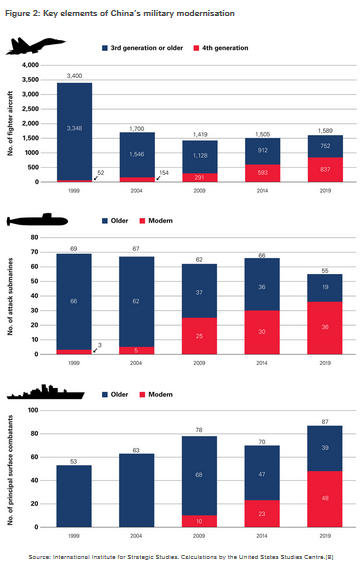America’s “..capacity to uphold a favorable balance of power [In the Indo-Pacific] is increasingly uncertain.” could be the one-line summary of a new report published August 19th by the United States Studies Centre at the University of Sydney.
It’s a long piece and alarmist in places; but the central argument i.e. that America’s military capability in the Pacific theater, relative to China’s, has deteriorated in recent years is hard to argue with.
Here’s just one graphic that nicely brings the point home.

Although long-ish the report is an easy read, but if you don’t have time here are the most important points:
- Two decades of distraction in the Middle-East (ME) have left America unprepared for a conflict with China.
- America’s military primacy in the Indo-Pacific region is over.
- A failure to modernize has left America in a position of ‘strategic insolvency’. It can no longer do what it wants, where and how it wants to.
- In 1995 America and its allies accounted for 80% of global military spending. That number today is 52%. As resources have shrunk the number of threats has grown.
- Since the ‘War on Terror’ began in 2001 America has spent approximately U$1.8tn dollars with no strategic payoff [Seen the latest in Afghanistan? Er, go the Taliban! Or do we mean come back?].
- America needs to stop fighting rogue states and terrorists that don’t matter and concentrate on the great powers (Russia and China) that can change the world.
- There’s broad support in the U.S. for the notion that China is now America’s greatest threat; but bickering politicians can’t agree what needs to be cut to fund spending to address this.
- The U.S. defense budget is large but capriciously and unreliably allocated by, again, those bickering politicians. This leaves military men uncertain how to pitch, when, and for what.
- The U.S.’s finances are not, in fact, very sound. The present debt-GDP ratio is among the highest of any country in the world and this is in the context of a booming economy. What happens when things aren’t going so well?
- The cost of maintaining the military complex have been persistently rising faster than inflation. New kit just costs more and benefits, especially medical, for service men and women have and will continue to go only one way.
- Advantages like stealth-technology and precision-guided munitions gave the U.S. a big advantage in the 1990s; but the advantage of these technologies has been eroded by the new missile capabilities of competitors
- The ‘forward base’ strategy of the U.S in the region, with bases in Yokuska, Guam and etcetera, could be more a liability than an asset in a conflict involving China’s advanced missile systems.
It’s not all bad news. The report concludes the U.S. is NOT, yet at least, a paper tiger in the region. A re-balance away from the ME is essential though. Partners in the region also need to step up cooperation and spending and, in the case of Australia, more attention needs to be given to increasing military capability and readiness. Especially in the north.
You can access the report in full via this link America versus China in the Indo-Pacific.
Happy Sunday.